Motion
In everyday life, we see some objects at rest and others in motion. Birds fly, fish swim, blood flows through veins and arteries, and cars move. Atoms, molecules, planets, stars and galaxies are all in motion. We often perceive an object to be in motion when its position changes with time. However, there are situations where the motion is inferred through indirect evidences. For example, we infer the motion of air by observing the movement of dust and the movement of leaves and branches of trees. What causes the phenomena of sunrise, sunset and changing of seasons? Is it due to the motion of the earth? If it is true, why don’t we directly perceive the motion of the earth?
An object may appear to be moving for one person and stationary for some other. For the passengers in a moving bus, the roadside trees appear to be moving backwards. A person standing on the road-side perceives the bus alongwith the passengers as moving. However, a passenger inside the bus sees his fellow passengers to be at rest. What do these observations indicate?
Most motions are complex. Some objects may move in a straight line, others may take a circular path. Some may rotate and a few others may vibrate. There may be situations involving a combination of these. In this chapter, we shall first learn to describe the motion of objects along a straight line. We shall also learn to express such motions through simple equations and graphs. Later, we shall discuss ways of describing circular motion.
Activity 7.1
- Discuss whether the walls of your classroom are at rest or in motion.
Activity 7.2
-
Have you ever experienced that the train in which you are sitting appears to move while it is at rest?
-
Discuss and share your experience.
Think and Act
We sometimes are endangered by the motion of objects around us, especially if that motion is erratic and uncontrolled as observed in a flooded river, a hurricane or a tsunami. On the other hand, controlled motion can be a service to human beings such as in the generation of hydro-electric power. Do you feel the necessity to study the erratic motion of some objects and learn to control them?
7.1 Describing Motion
We describe the location of an object by specifying a reference point. Let us understand this by an example. Let us assume that a school in a village is
7.1.1 MOTION ALONG A STRAIGHT LINE
The simplest type of motion is the motion along a straight line. We shall first learn to describe this by an example. Consider the motion of an object moving along a straight path. The object starts its journey from

Fig. 7.1: Positions of an object on a straight line path
Can the magnitude of the displacement be equal to the distance travelled by an object? Consider the example given in (Fig. 7.1). For motion of the object from
Activity 7.3
-
Take a metre scale and a long rope. Walk from one corner of a basket-ball court to its oppposite corner along its sides.
-
Measure the distance covered by you and magnitude of the displacement.
-
What difference would you notice between the two in this case?
Activity 7.4
-
Automobiles are fitted with a device that shows the distance travelled. Such a device is known as an odometer. A car is driven from Bhubaneshwar to New Delhi. The difference between the final reading and the initial reading of the odometer is
-
Find the magnitude of the displacement between Bhubaneshwar and New Delhi by using the Road Map of India.
Questions
1. An object has moved through a distance. Can it have zero displacement? If yes, support your answer with an example.
Show Answer
Answer
Yes, an object can have zero displacement even when it has moved through a distance.This happens when final position of the object coincides with its initial position. For example, if a person moves around park and stands on place from where he started then here displacement will be zero.
2. A farmer moves along the boundary of a square field of side
Show Answer
Answer

Given, Side of the square field
Therefore, perimeter
Farmer moves along the boundary in 40 s.
Displacement after
Since in
Therefore, in 1s distance covered by farmer
Therefore, in 140s distance covered by farmer
Thus, after 3.5 round farmer will at point
Therefore. Displacement
Thus, after 2 min 20 seconds the displacement of farmer will be equal to
3. Which of the following is true for displacement?
(a) It cannot be zero.
(b) Its magnitude is greater than the distance travelled by the object.
Show Answer
Answer
None of the statement is true for displacement First statement is false because displacement can be zero. Second statement is also false because displacement is less than or equal to the distance travelled by the object.
7.1.2 UNIFORM MOTION AND NONUNIFORM MOTION
Consider an object moving along a straight line. Let it travel
Activity 7.5
-
The data regarding the motion of two different objects A and B are given in Table 7.1.
-
Examine them carefully and state whether the motion of the objects is uniform or non-uniform.
Table 7.1
| Time | Distance travelled by object A in |
Distance travelled by object B in |
|---|---|---|
| 9:30 am | 10 | 12 |
| 9:45 am | 20 | 19 |
| 10:00 am | 30 | 23 |
| 10:15 am | 40 | 35 |
| 10:30 am | 50 | 37 |
| 10:45 am | 60 | 41 |
| 11:00 am | 70 | 44 |
7.2 Measuring the Rate of Motion

Fig. 7.2 (b)
Look at the situations given in Fig. 7.2. If the bowling speed is
Different objects may take different amounts of time to cover a given distance. Some of them move fast and some move slowly. The rate at which objects move can be different. Also, different objects can move at the same rate. One of the ways of measuring the rate of motion of an object is to find out the distance travelled by the object in unit time. This quantity is referred to as speed. The SI unit of speed is metre per second. This is represented by the symbol
If an object travels a distance
Let us understand this by an example. A car travels a distance of
Example 7 .1 An object travels
Solution:
Total distance travelled by the object
Total time taken
Therefore, the average speed of the object is
7.2.1 SPEED WITH DIRECTION
The rate of motion of an object can be more comprehensive if we specify its direction of motion along with its speed. The quantity that specifies both these aspects is called velocity. Velocity is the speed of an object moving in a definite direction. The velocity of an object can be uniform or variable. It can be changed by changing the object’s speed, direction of motion or both. When an object is moving along a straight line at a variable speed, we can express the magnitude of its rate of motion in terms of average velocity. It is calculated in the same way as we calculate average speed.
In case the velocity of the object is changing at a uniform rate, then average velocity is given by the arithmetic mean of initial velocity and final velocity for a given period of time. That is,
average velocity
where
Speed and velocity have the same units, that is,
Activity 7.6
- Measure the time it takes you to walk from your house to your bus stop or the school. If you consider that your average walking speed is
Activity 7.7
-
At a time when it is cloudy, there may be frequent thunder and lightning. The sound of thunder takes some time to reach you after you see the lightning.
-
Can you answer why this happens? Measure this time interval using a digital wrist watch or a stop watch.
-
Calculate the distance of the nearest point of lightning. (Speed of sound in air
Questions
1. Distinguish between speed and velocity.
Show Answer
Answer
| Speed | Velocity |
|---|---|
| Speed is the distance travelled by an object in a given interval of time. |
Velocity is the displacement of an object in a given interval of time. |
| Speed = distance / time | Velocity = displacement / time |
| Speed is scalar quantity i.e. it has only magnitude. |
Velocity is vector quantity i.e. it has both magnitude as well as direction. |
2. Under what condition(s) is the magnitude of average velocity of an object equal to its average speed?
Show Answer
Answer
The magnitude of average velocity of an object is equal to its average speed, only when an object is moving in a straight line.
3. What does the odometer of an automobile measure?
Show Answer
Answer
The odometer of an automobile measures the distance covered by an automobile.
4. What does the path of an object look like when it is in uniform motion?
Show Answer
Answer
An object having uniform motion has a straight line path.
5. During an experiment, a signal from a spaceship reached the ground station in five minutes. What was the distance of the spaceship from the ground station? The signal travels at the speed of light, that is,
Show Answer
Answer
Speed
Time
Distance
Example 7.2 The odometer of a car reads
Solution:
Distance covered by the car,
Average speed of the car is,
The average speed of the car is
Example 7.3 Usha swims in a
Solution:
Total distance covered by Usha in
Displacement of Usha in
Average speed
Average velocity
The average speed of Usha is
7.3 Rate of Change of Velocity
During uniform motion of an object along a straight line, the velocity remains constant with time. In this case, the change in velocity of the object for any time interval is zero. However, in non-uniform motion, velocity varies with time. It has different values at different instants and at different points of the path. Thus, the change in velocity of the object during any time interval is not zero. Can we now express the change in velocity of an object?
To answer such a question, we have to introduce another physical quantity called acceleration, which is a measure of the change in the velocity of an object per unit time. That is,
If the velocity of an object changes from an initial value
This kind of motion is known as accelerated motion. The acceleration is taken to be positive if it is in the direction of velocity and negative when it is opposite to the direction of velocity. The SI unit of acceleration is
If an object travels in a straight line and its velocity increases or decreases by equal amounts in equal intervals of time, then the acceleration of the object is said to be uniform. The motion of a freely falling body is an example of uniformly accelerated motion. On the other hand, an object can travel with non-uniform acceleration if its velocity changes at a non-uniform rate. For example, if a car travelling along a straight road increases its speed by unequal amounts in equal intervals of time, then the car is said to be moving with non-uniform acceleration.
Activity 7.8
In your everyday life you come across a range of motions in which
(a) acceleration is in the direction of motion,
(b) acceleration is against the direction of motion,
(c) acceleration is uniform,
(d) acceleration is non-uniform.
- Can you identify one example each for the above type of motion?
Example 7.4 Starting from a stationary position, Rahul paddles his bicycle to attain a velocity of
Solution:
In the first case:
initial velocity,
final velocity,
time,
From Eq. (8.3), we have
Substituting the given values of
In the second case:
initial velocity,
final velocity,
time,
Then,
The acceleration of the bicycle in the first case is
Questions
1. When will you say a body is in (i) uniform acceleration? (ii) nonuniform acceleration?
Show Answer
Answer
(i) A body is said to be in uniform acceleration if it travels in a straight line and its velocity increases or decreases by equal amounts in equal intervals of time.
(ii) A body is said to be in nonuniform acceleration if the rate of change of its velocity is not constant.
2. A bus decreases its speed from
Show Answer
Answer
Initial speed of the bus,
Final speed of the bus,
Time take to decrease the speed,
Acceleration,
3. A train starting from a railway station and moving with uniform acceleration attains a speed 40 km h–1 in 10 minutes. Find its acceleration.
Show Answer
Answer
Initial velocity of the train,
Final velocity of the train,
Time taken,
Acceleration,
Hence, the acceleration of the train is
7.4 Graphical Representation of Motion
Graphs provide a convenient method to present basic information about a variety of events. For example, in the telecast of a one-day cricket match, vertical bar graphs show the run rate of a team in each over. As you have studied in mathematics, a straight line graph helps in solving a linear equation having two variables.
To describe the motion of an object, we can use line graphs. In this case, line graphs show dependence of one physical quantity, such as distance or velocity, on another quantity, such as time.
7.4.1 DISTANCE-TIME GRAPHS
The change in the position of an object with time can be represented on the distance-time graph adopting a convenient scale of choice. In this graph, time is taken along the

Fig. 7.3: Distance-time graph of an object moving with uniform speed
We know that when an object travels equal distances in equal intervals of time, it moves with uniform speed. This shows that the
distance travelled by the object is directly proportional to time taken. Thus, for uniform speed, a graph of distance travelled against time is a straight line, as shown in Fig. 7.3. The portion OB of the graph shows that the distance is increasing at a uniform rate. Note that, you can also use the term uniform velocity in place of uniform speed if you take the magnitude of displacement equal to the distance travelled by the object along the
We can use the distance-time graph to determine the speed of an object. To do so, consider a small part
We can also plot the distance-time graph for accelerated motion. Table 7.2 shows the distance travelled by a car in a time interval of two seconds.
Table 7.2: Distance travelled by a car at regular time intervals Time in seconds Distance in metres
| Time in second | Distance in metres |
|---|---|
| 0 | 0 |
| 2 | 1 |
| 4 | 4 |
| 6 | 9 |
| 8 | 16 |
| 10 | 25 |
| 12 | 36 |

Fig. 7.4: Distance-time graph for a car moving with non-uniform speed
The distance-time graph for the motion of the car is shown in Fig. 7.4. Note that the shape of this graph is different from the earlier distance-time graph (Fig. 7.3) for uniform motion. The nature of this graph shows nonlinear variation of the distance travelled by the car with time. Thus, the graph shown in Fig 7.4 represents motion with non-uniform speed.
7.4.2 VELOCITY-TIME GRAPHS
The variation in velocity with time for an object moving in a straight line can be represented by a velocity-time graph. In this graph, time is represented along the

Fig. 7.5: Velocity-time graph for uniform motion of a car is represented along the
We know that the product of velocity and time give displacement of an object moving with uniform velocity. The area enclosed by velocity-time graph and the time axis will be equal to the magnitude of the displacement.
To know the distance moved by the car between time
So, the distance
We can also study about uniformly accelerated motion by plotting its velocitytime graph. Consider a car being driven along a straight road for testing its engine. Suppose a person sitting next to the driver records its velocity after every 5 seconds by noting the reading of the speedometer of the car. The velocity of the car, in
Table 7.3: Velocity of a car at regular instants of time
| 0 | 0 | 0 |
| 5 | 2.5 | 9 |
| 10 | 5.0 | 18 |
| 15 | 7.5 | 27 |
| 20 | 10.0 | 36 |
| 25 | 12.5 | 45 |
| 30 | 15.0 | 54 |
In this case, the velocity-time graph for the motion of the car is shown in Fig. 7.6. The nature of the graph shows that velocity changes by equal amounts in equal intervals of time. Thus, for all uniformly accelerated motion, the velocity-time graph is a straight line.

Fig. 7.6: Velocity-time graph for a car moving with uniform accelerations.
You can also determine the distance moved by the car from its velocity-time graph. The area under the velocity-time graph gives the distance (magnitude of displacement) moved by the car in a given interval of time. If the car would have been moving with uniform velocity, the distance travelled by it would be represented by the area
In the case of non-uniformly accelerated motion, velocity-time graphs can have any shape.

(a)

(b)
Fig. 7.7: Velocity-time graphs of an object in nonuniformly accelerated motion.
Fig. 7.7(a) shows a velocity-time graph that represents the motion of an object whose velocity is decreasing with time while Fig. 7.7 (b) shows the velocity-time graph representing the non-uniform variation of velocity of the object with time. Try to interpret these graphs.
Activity 7.9
- The times of arrival and departure of a train at three stations
Table 7.4: Distances of stations B and
| Station | Distance from A (km) | Time of arrival (hours) | Time of departure (hours) |
|---|---|---|---|
| A | 0 | ||
| B | 120 | ||
| C | 180 |
- Plot and interpret the distance-time graph for the train assuming that its motion between any two stations is uniform.
Activity 7.10
Feroz and his sister Sania go to school on their bicycles. Both of them start at the same time from their home but take different times to reach the school although they follow the same route. Table 7.5 shows the distance travelled by them in different times
| Time | Distance travelled by Feroz |
Distance travelled by Sania |
|---|---|---|
| 8:00 am | 0 | 0 |
| 8:05 am | 1.0 | 0.8 |
| 8:10 am | 1.9 | 1.6 |
| 8:15 am | 2.8 | 2.3 |
| 8:20 am | 3.6 | 3.0 |
| 8:25 am | - | 3.6 |
- Plot the distance-time graph for their motions on the same scale and interpret.
Questions
1. What is the nature of the distance-time graphs for uniform and non-uniform motion of an object?
Show Answer
Answer
When the motion is uniform, the distance time graph is a straight line with a slope.

When the motion is non uniform, the distance time graph is not a straight line.It can be any curve.

2. What can you say about the motion of an object whose distance-time graph is a straight line parallel to the time axis?
Show Answer
Answer
If distance time graph is a straight line parallel to the time axis, the body is at rest.

3. What can you say about the motion of an object if its speedtime graph is a straight line parallel to the time axis?
Show Answer
Answer
If speed time graph is a straight line parallel to the time axis, the object is moving uniformly.

4. What is the quantity which is measured by the area occupied below the velocity-time graph?
Show Answer
Answer
The area below velocity-time graph gives the distance covered by the object.
7.5 Equations of Motion
When an object moves along a straight line with uniform acceleration, it is possible to relate its velocity, acceleration during motion and the distance covered by it in a certain time interval by a set of equations known as the equations of motion. For convenience, a set of three such equations are given below:
where
Example 7.5 A train starting from rest attains a velocity of
Solution:
We have been given
(i) From Eq. (7.5) we know that
(ii) From Eq. (7.7) we have
Thus,
The acceleration of the train is
Example 7.6 A car accelerates uniformly from
Solution:
We are given that
(i) From Eq. (7.5) we have
(ii) From Eq. (7.6) we have
The acceleration of the car is
Example 7.7 The brakes applied to a car produce an acceleration of
Solution:
We have been given
From Eq. (7.5) we know that
or
From Eq. (7.6) we get
Thus, the car will move
Questions
1. A bus starting from rest moves with a uniform acceleration of
Show Answer
Answer
Initial speed of the bus,
Acceleration,
Time taken,
(a)
(b) According to the third equation of motion:
Where,
Speed acquired by the bus is
Distance travelled by the bus is
2. A train is travelling at a speed of
Show Answer
Answer
Initial speed of the train,
Final speed of the train,
Acceleration
According to third equation of motion:
Where,
The train will cover a distance of
3. A trolley, while going down an inclined plane, has an acceleration of
Show Answer
Answer
Initial Velocity of trolley,
Acceleration,
Time,
We know that final velocity,
Therefore, The velocity of train after 3 seconds
4. A racing car has a uniform acceleration of
Show Answer
Answer
Initial Velocity of the car,
Acceleration,
Time,
We know Distance,
Therefore, Distance covered by car in 10 second
5. A stone is thrown in a vertically upward direction with a velocity of
Show Answer
Answer
Given Initial velocity of stone,
Downward of negative Acceleration,
We know that
Therefore, Height attained by the stone,
Also we know that final velocity,
or, Time,
Therefore, Time,
7.6 Uniform Circular Motion
When the velocity of an object changes, we say that the object is accelerating. The change in the velocity could be due to change in its magnitude or the direction of the motion or both. Can you think of an example when an object does not change its magnitude of velocity but only its direction of motion?

Fig. 7.8: The motion of an athlete along closed tracks of different shapes.
Let us consider an example of the motion of a body along a closed path. Fig 8.9 (a) shows the path of an athlete along a rectangular track
Now, suppose instead of a rectangular track, the athlete is running along a hexagonal shaped path
We know that the circumference of a circle of radius
When an object moves in a circular path with uniform speed, its motion is called uniform circular motion.
Activity 7.11
- Take a piece of thread and tie a small piece of stone at one of its ends. Move the stone to describe a circular path with constant speed by holding the thread at the other end, as shown in Fig. 7.9.

Fig. 7.9: A stone describing a circular path with a velocity of constant magnitude.
-
Now, let the stone go by releasing the thread.
-
Can you tell the direction in which the stone moves after it is released?
-
By repeating the activity for a few times and releasing the stone at different positions of the circular path, check whether the direction in which the stone moves remains the same or not.
If you carefully note, on being released the stone moves along a straight line tangential to the circular path. This is because once the stone is released, it continues to move along the direction it has been moving at that instant. This shows that the direction of motion changed at every point when the stone was moving along the circular path.
When an athlete throws a hammer or a discus in a sports meet, he/she holds the hammer or the discus in his/her hand and gives it a circular motion by rotating his / her own body. Once released in the desired direction, the hammer or discus moves in the direction in which it was moving at the time it was released, just like the piece of stone in the activity described above. There are many more familiar examples of objects moving under uniform circular motion, such as the motion of the moon and the earth, a satellite in a circular orbit around the earth, a cyclist on a circular track at constant speed and so on.
What you have learnt

-
Motion is a change of position; it can be described in terms of the distance moved or the displacement.
-
The motion of an object could be uniform or non-uniform depending on whether its velocity is constant or changing.
-
The speed of an object is the distance covered per unit time, and velocity is the displacement per unit time.
-
The acceleration of an object is the change in velocity per unit time.
-
Uniform and non-uniform motions of objects can be shown through graphs.
-
The motion of an object moving at uniform acceleration can be described with the help of the following equations, namely
where
-
If an object moves in a circular path with uniform speed, its motion is called uniform circular motion.
Exercises
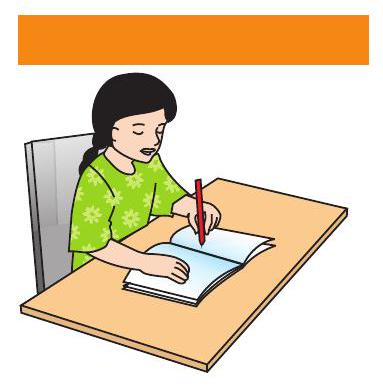
1. An athlete completes one round of a circular track of diameter
Show Answer
Answer
Diameter of circular track (D)
Radius of circular track
Time taken by the athlete for one round
Distance covered by athlete in one round
Speed of the athlete
Therefore, Distance covered in
Number of round in
Number of round in
After taking start from position
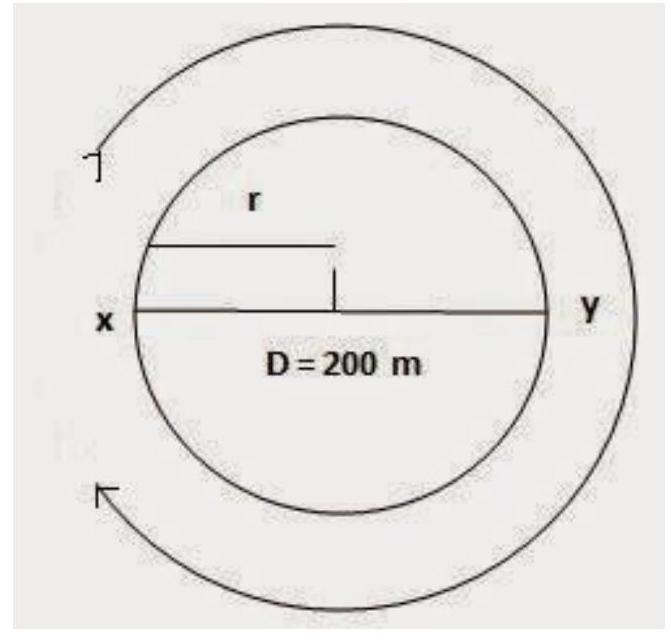
Hence, Displacement of the athlete with respect to initial position at
2. Joseph jogs from one end A to the other end B of a straight
Show Answer
Answer
Total Distance covered from
Total time taken

Therefore, Average Speed from AB = Total Distance / Total Time
Therefore, Velocity from AB =Displacement AB
Total Distance covered from
Total time taken from A to C = Time taken for AB + Time taken for BC
Therefore, Average Speed from AC = Total Distance /Total Time
Displacement (S) from
Time (t) taken for displacement from AC
Therefore, Velocity from AC = Displacement (s) / Time (t)
3. Abdul, while driving to school, computes the average speed for his trip to be
Show Answer
Answer
The distance Abdul commutes while driving from Home to School
4. A motorboat starting from rest on a lake accelerates in a straight line at a constant rate of
Show Answer
Answer
Given Initial velocity of motorboat,
Acceleration of motorboat,
Time under consideration,
We know that Distance,
Therefore, The distance travel by motorboat
5. A driver of a car travelling at
Show Answer
missing6. Fig 7.10 shows the distance-time graph of three objects A,B and
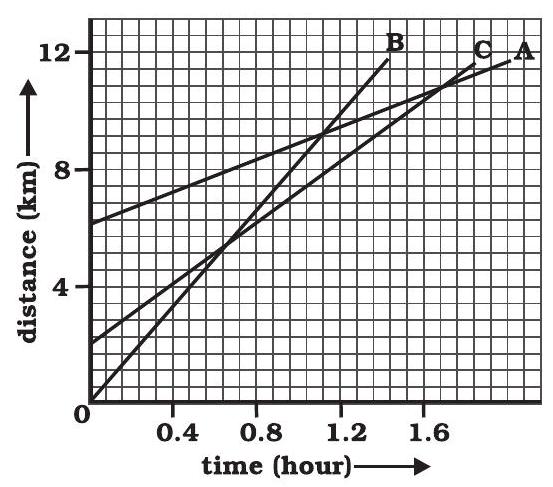
Fig. 7.10
(a) Which of the three is travelling the fastest?
(b) Are all three ever at the same point on the road?
(c) How far has C travelled when B passes A?
(d) How far has B travelled by the time it passes C?
Show Answer
Answer
(a) Object B
(b) No
(c)
(d)
(a) Speed
Slope of graph
Therefore, Speed = slope of the graph
Since slope of object B is greater than objects A and C, it is travelling the fastest.
(b) All three objects A, B and C never meet at a single point. Thus, they were never at the same point on road.
(c)
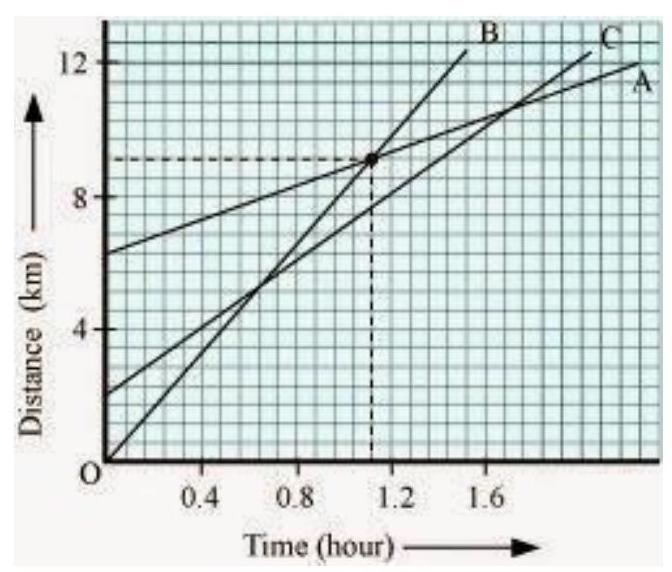
Since there are 7 unit areas of the graph between 0 and 4 on the Y axis, 1 graph unit equals
Since the initial point of an object C is 4 graph units away from the origin, Its initial distance from the origin is
When B passes A, the distance between the origin and C is
Therefore, total distance travelled by C in this time =
(d) The distance that object B has covered at the point where it passes C is equal to 9 graph units.
Therefore, total distance travelled by B when it crosses C =
7. A ball is gently dropped from a height of
Show Answer
Answer
Let us assume, the final velocity with which ball will strike the ground be ’
Distance or height of fall,
Downward acceleration,
As we know,
8. The speed-time graph for a car is shown is Fig. 7.11.
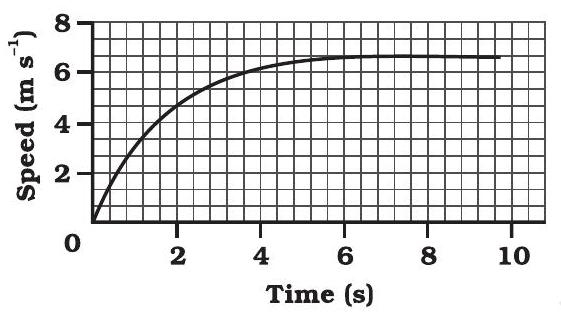
Fig. 7.11
(a) Find how far does the car travel in the first 4 seconds. Shade the area on the graph that represents the distance travelled by the car during the period.
(b) Which part of the graph represents uniform motion of the car?
Show Answer
Answer
(a)
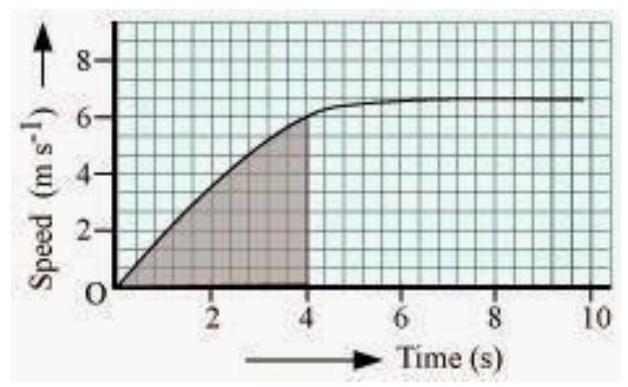
The shaded area which is equal to
(b)
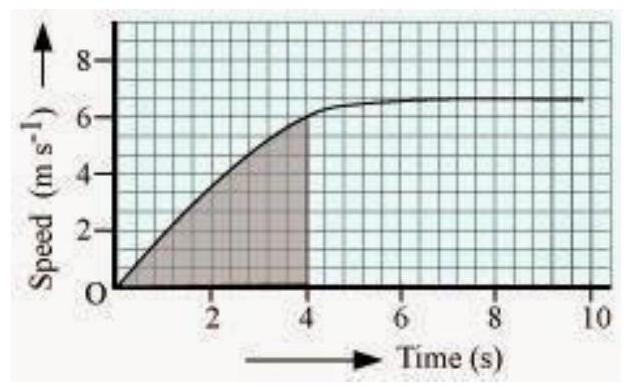
The part of the graph in red colour between time
9. State which of the following situations are possible and give an example for each of these:
(a) an object with a constant acceleration but with zero velocity
(b) an object moving with an acceleration but with uniform speed.
(c) an object moving in a certain direction with an acceleration in the perpendicular direction.
Show Answer
Answer
(a) It is possible; an object thrown up into the air has a constant acceleration due to gravity acting on it. However, when it reaches its maximum height, its velocity is zero.
(b) It is possible; acceleration implies an increase or decrease in speed, and uniform speed implies that the speed does not change over time
Circular motion is an example of an object moving with acceleration but with uniform speed.
An object moving in a circular path with uniform speed is still under acceleration because the velocity changes due to continuous changes in the direction of motion.
(c) It is possible; for an object accelerating in a circular trajectory, the acceleration is perpendicular to the direction followed by the object.
10. An artificial satellite is moving in a circular orbit of radius
Show Answer
Answer
Radius of the circular orbit,
Time taken to revolve around the earth,
Speed of a circular moving object,










